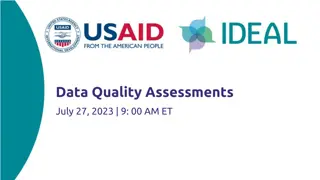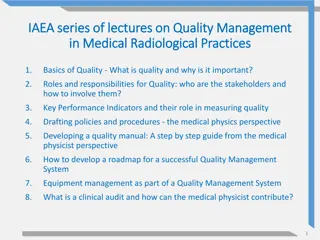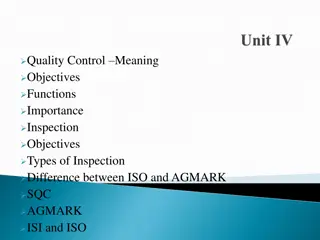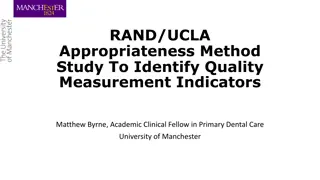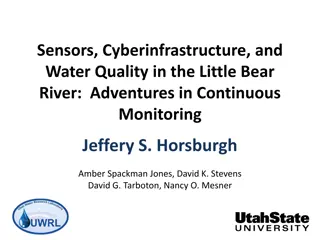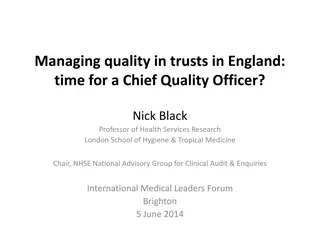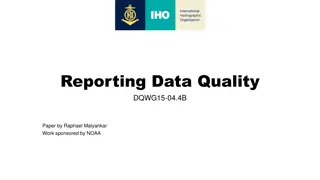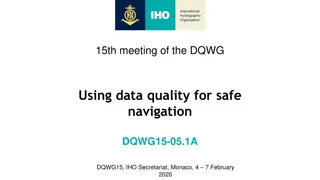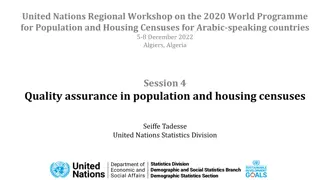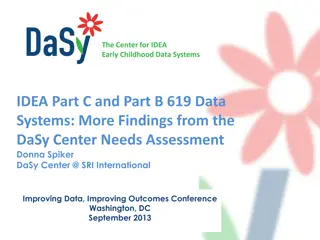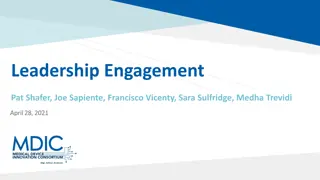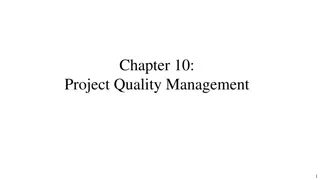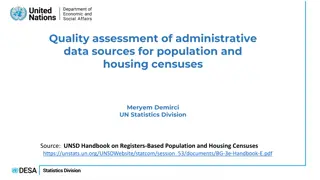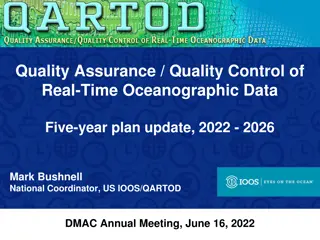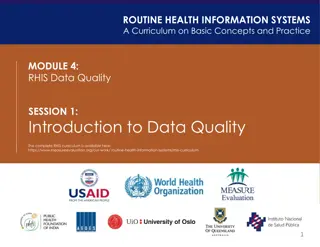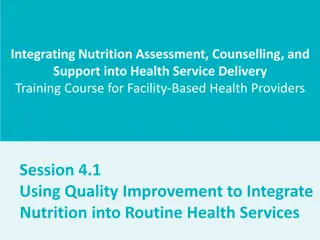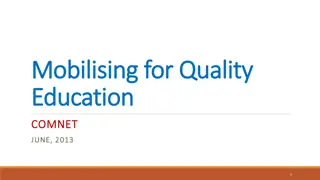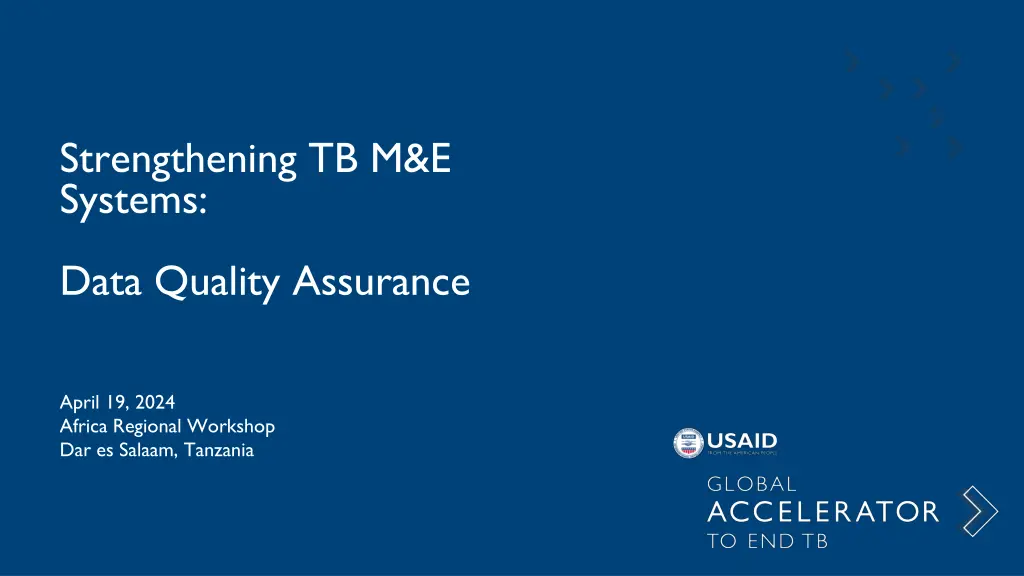
Strengthening TB M&E Systems for Data Quality Assurance in Africa Regional Workshop
Explore the importance of data quality assessments for reporting metrics to external stakeholders like Congress and the American People. Learn about the processes and policies outlined in USAID's Operations Management Plan for assessing data quality in TB programs.
Download Presentation

Please find below an Image/Link to download the presentation.
The content on the website is provided AS IS for your information and personal use only. It may not be sold, licensed, or shared on other websites without obtaining consent from the author. If you encounter any issues during the download, it is possible that the publisher has removed the file from their server.
You are allowed to download the files provided on this website for personal or commercial use, subject to the condition that they are used lawfully. All files are the property of their respective owners.
The content on the website is provided AS IS for your information and personal use only. It may not be sold, licensed, or shared on other websites without obtaining consent from the author.
E N D
Presentation Transcript
Strengthening TB M&E Systems: Data Quality Assurance April 19, 2024 Africa Regional Workshop Dar es Salaam, Tanzania
Context for Todays Discussion Congress provides funding to USAID and expects us to generate results $ US USAID Congress Data on Results
$$ TRAVELS FROM CONGRESS TO THE PROGRAM AREAS $
Performance Plan and Report (PPR) ... AND RESULTS ARE REPORTED FROM PROGRAM AREA TO U.S. CONGRESS AND THE AMERICAN PEOPLE Data on Results US Congress
BRINGING US TO TODAYS TOPIC: DATA QUALITY ASSESSMENTS ADS 597^: For any metric reported by the Agency to External Stakeholders, data quality assessments are required to be conducted. External Stakeholders = Congress and The American People ADS does not prescribe a specific way to conduct DQAs A description of the DQA the processes should accompany the Mission s OP (OP = Operations Management Plan: A three-year strategic plan for each USAID Mission) ^ The ADS contains the policies and procedures that guide USAID's programs and operations.
BRINGING US TO TODAYS TOPIC: DATA QUALITY ASSESSMENTS ADS 597^: For any metric reported by the Agency to External Stakeholders, data quality assessments are required to be conducted. External Stakeholders = Congress and The American People ADS does not prescribe a specific way to conduct DQAs A description of the DQA the processes should accompany the Mission s OP (OP = Operations Management Plan: A three-year strategic plan for each USAID Mission) Missions: Do you know what your OP says about how data quality is assessed for TB? ^ The ADS contains the policies and procedures that guide USAID's programs and operations.
LETS COME TOGETHER AND DEFINE DATA QUALITY ASSURANCE IN A WAY THAT MAKES SENSE FOR TB The risk if we don't... Somebody else may define this for us to follow...
Agenda 1. 2. 3. 4. Introduction to Case Study Group Work Ideation Session Recap and Summary
NOT A REAL FLAG Welcome to Zaccosia NOT A REAL COUNTRY
Legal Disclaimer: This is a work of fiction. Unless otherwise indicated, all the names, facts, data, information, places, events and incidents in this case study are the product of imagination. Any resemblance to actual countries and events, past, present or future are purely coincidental. ONCE AGAIN... Zaccosia is NOT a real country. The data we will be using is MADE UP
Q: But are we using real data? Frequently Asked Questions: Q: Is Zaccosia a real country? A: NO!!! The data is 100% fabricated A: NO!!! the country is a work of fiction
The Government Accountability Office (GAO) conducted a review of DQA protocols and results for USAID Health Program indicators. Their report to congress found USAID s data quality controls were OK for project-level data but are not sufficient for indicator data sourced from bilateral stakeholders.
The Government Accountability Office (GAO) conducted a review of DQA protocols and results for USAID Health Program indicators. Their report to congress found USAID s data quality controls were OK for project-level data but are not sufficient for indicator data sourced from bilateral stakeholders. <-- PPR Indicators <-- Accelerator Call Indicators
In response, the program offices at every USAID mission begun reviewing and updating their OPs for non-project indicators which include the TB Indicators reported in the PPR. Despite uniform TB indicators reported across countries, lack of consistent guidance on data quality resulted in different DQA protocols from the program offices in each mission, variations in technical approach and operational feasibility are expected. In other words: We didn t define a process, and now a process is being defined for us to follow...
To get ahead of this, USAID TB begun drafting guidance to inform the DQA approach for TB programs and indicators. As an M&E expert imbedded within Zaccosia MoH, you have earned a reputation for objective analysis. You have agreed to support an effort to inform this guidance.
You begin by visiting a facility and re-familiarizing yourself with the patient registers...
You begin by visiting a facility and re-familiarizing yourself with the patient registers... A few rules: 1. Zaccosia adheres to the guidance attached on the tally sheet (WHO Definitions and reporting framework for TB 2013 rev) 1. Info may be missing from this guidance, please use knowledge and assumptions to fill gaps. 1. Patient treatment cards are not provided (treatment history, weight, height, bmi, etc.) 1. There are not always a clear right answer for these We ve intentionally added ambiguity to emphasize challenges with a standard approach
DISTRIBUTE REGISTERS https://drive.google.c om/file/d/1vseE- 7NfLnI- TdVWlY10AnruNKf1P O3K/view?usp=drive_ link https://drive.goo gle.com/file/d/1H VA5- FBKTq4ibBROG STux274ARJCDr 5K/view?usp=dri ve_link https://drive.google.co m/file/d/1R_EegNpUqG Of0AkZCFySvlrecThQc gtv/view?usp=drive_lin k
Key questions for discussion as you go through the process: How would you change the register to help with counting / aggregation? While some countries conduct their own DQA, USAID is required by ADS to conduct one as well. How did you handle missing / incorrect values? How can USAID s DQA be designed to complement existing efforts? Did your team agree on a methodology for counting each number? What can USAID do to integrate DQA findings at the national level? Would a disaggregate (>10 different age disaggs) significantly increase risk of error? What are the key areas for USAD TB DQA guidance to address? How do we ensure data / reporting changes can be implemented?
After-activity Discussion 1. How many people in total were logged in the DS-TB treatment register? How Total Notifications were reported under the facility? 1. How many people reported under the facility are Bacteriologically confirmed? Bonus question: Did you include all with a positive mWRD result? 1. How many cases reported by the facility were cured, how many completed treatment?
Should the accuracy of patient chart / register be in scope of the DQA? Example: No smear / culture result at end of treatment. Count as marked or change the clinical records? Clinician did not follow WHO recommendations, but client DID receive a mWRD and DID test positive. TB screening date and results were not completed, should we still count as screened?
Should the accuracy of patient chart / register be in scope of the DQA? Example: No smear / culture result at end of treatment. Count as marked or change the clinical records? If we make a judgements on a case-by-case, how do we ensure a consistent and efficient DQA process? Clinician did not follow WHO recommendations, but client DID receive a mWRD and DID test positive. TB screening date and results were not completed, should we still count as screened? record, we should interpret registers literally. One viewpoint: Unless we adjust the official
Questions for discussion While some countries conduct their own DQA, USAID is required by ADS to conduct one as well. How would you change the design to help with counting / aggregation? How can USAID s DQA be designed to complement national data quality activities? Consider how a new disaggregate (>10 different age disaggs) increase risk of error? What has USAID done to integrate findings at the national level? How do we ensure data / reporting changes can be implemented? How detailed should the DQA protocols be? How did you handle missing / incorrect / conflicting values? Did your team agree on a methodology for counting each number?

